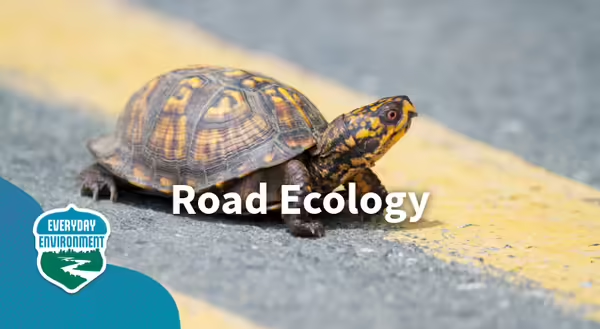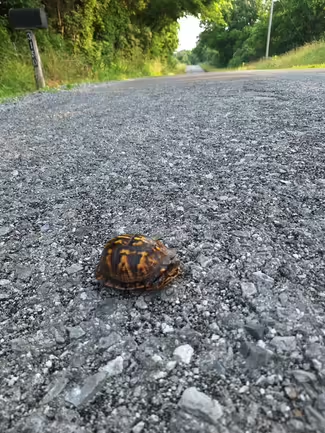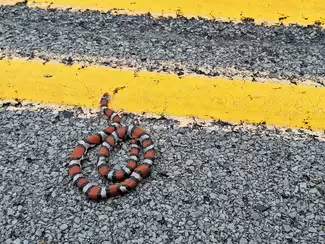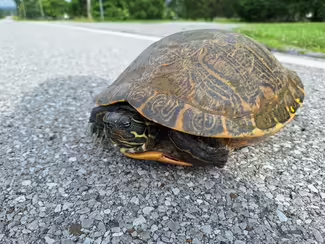
While commuting to work in southernmost Illinois, I regularly lament seeing crushed eastern box turtles and other roadkill along the mostly rural roads. I sometimes see as many as 5-10 living eastern box turtles on the road in the morning. Unfortunately, I do not always have time or feel that it is safe to move them. (Please note, if you choose to move turtles out of a road, only do so when safe, and do not risk your safety or that of others).
On my way home, I always fear I’ll see that one or more of the morning crossers did not make it. Sometimes they do and sometimes they don't. Despite the many adverse effects of roads on wildlife, people nationwide are working hard to change and adapt our roadways to reduce their negative impacts. There have been many improvements and discoveries in recent years that will help people in that endeavor.
Millions of miles of roads cover the U.S.
There are nearly 4 million miles of roadway in the U.S. that give people access to almost anywhere at any time. This has its benefits for people, but also numerous ecological drawbacks.
An estimated 1 million vertebrate wildlife are killed by vehicles every day in the U.S. Wildlife fatally struck by vehicles, roadkill, is the most common and most visible impact of roads, but the environmental fallout ranges from habitat destruction and fragmentation to light and noise pollution, water pollution from vehicles and road salt, and microplastics and chemicals from tires. Large highways are problematic for wildlife due to fatalities and blocking migrations, but even dirt roads through prairies or forests can kill wildlife and disconnect habitat.
Collisions, especially with large animals like deer, can also be costly for people, resulting in fatalities, injuries, and totaled vehicles. In 2023, the Illinois Department of Transportation reported 14,862 vehicle crashes involving deer; 633 caused injuries, and 7 resulted in fatalities.
One of the main issues around roadkill is that people either don’t think about it or may think the deaths are insignificant for wildlife populations. Roadkill can be a significant source of mortality for many species, and rare species are especially vulnerable to further declines.
Some groups, including reptiles and amphibians, are more likely to suffer steep declines due to road mortality. The timing of seasonal animal movements and migrations can be especially destructive. Amphibians and reptiles can be susceptible since they are often unaware of the danger of roads and may linger to warm themselves on the pavement (in the case of reptiles) or sometimes move across en masse during breeding or egg laying season (in the case of amphibians), resulting in mass casualty events, especially when coinciding with morning or afternoon human commutes.
More road problems for wildlife
Insects also suffer from roadkill, which is concerning considering their precipitous declines in recent years. One study found that billions of pollinators are killed on roads annually in North America. Global estimates reach into the hundreds of trillions of insects roadkilled each year. Another potentially problematic practice is the creation of pollinator habitat along roadways. Researchers have found that pollinator plantings along roads may reduce pollinator populations due to roadkill, but may depend on traffic volumes (Keilsohn et al 2018).
Another concept, defaunation, describes how roadkill and other factors are steadily leading to a decreasing number of even common wildlife species. While not necessarily threatening extinction, the smaller numbers may one day lead to rarity or cause other ecological problems, such as invasive species competition, habitat loss, and pollution, leading to systems with low biodiversity incapable of functioning as they would historically.
Tire wear is another road ecology issue that has seen recent attention. Microplastics are in the environment and are working through the food web, which is a concern. Tires shedding particles are a significant source of microplastics in the environment. However, there is no consensus yet on plastics’ effects on wildlife or people as they enter terrestrial ecosystems and the water supply. One study found that coho salmon are particularly susceptible to a toxin found in tire tread wear particles and may be linked to die-offs of coho salmon following rain (McIntyre et al. 2021).
A path to saving wildlife from becoming roadkill
Roads are here to stay for the foreseeable future, so people need to find ways to reduce or eliminate the negative aspects of roadways for wildlife and, ultimately, people. Fortunately, there are some things we already know how to do and are being refined to work even better.
Build passageways for wildlife to cross roadways
Building overpasses and underpasses creates a safe way for wildlife to cross roadways and is becoming more common. When combined with fencing that directs animals to the crossing and reduced speed limits in high-incidence areas, they can significantly reduce road mortality. These wildlife crossing structures can be built to accommodate different wildlife species of all sizes that may prefer one design over another.
Close roads during peak passage times
Another idea is to close roads altogether, as in the case of southern Illinois’ famous “Snake Road” in the Shawnee National Forest. Snake Road is a 2.5-mile stretch of gravel road managed by the U.S. Forest Service that is closed to vehicular traffic in the spring and fall to allow for reptiles and amphibians to migrate between their hibernacula (places where they find refuge during unfavorable seasons) in the cliffs and adjacent wetlands on the other side of the road. In addition to benefiting the herptiles that call that area home, the road closure also allows for the public to walk the road and observe numerous snakes, turtles, frogs, toads, salamanders, and more! A great time to visit is in the spring, when you have the chance to see both wildlife and spring ephemeral wildflowers along the roadside bluffs and wetland.
Learn More
For an engaging overview of road ecology, including recent research, solutions, and people working to alleviate the problems roads cause for wildlife and our environment, check out the 2023 book Crossings: How Road Ecology is Shaping the Future of Our Planet by Ben Goldfarb.
And check out this Everyday Environment webinar, Saving the World, One Box Turtle at a Time, about box turtle research at University of Illinois.
Animals trying to cross Southern Illinois roads
Left to right, Photo 1: A juvenile eastern box turtle (Terrapene carolina) on a road. Photo 2: A red milksnake (Lampropeltis triangulum syspila) that was found dead in May 2025 on the author's commute to work. Photo 3: A state-endangered river cooter (Pseudemys concinna) that the author helped across a rural road. This was a large female, presumably seeking a location to lay her eggs.
References
- Baxter-Gilbert, J. H., Riley, J. L., Neufeld, C. J., Litzgus, J. D., & Lesbarrères, D. (2015). Road mortality potentially responsible for billions of pollinating insect deaths annually. Journal of Insect Conservation, 19, 1029-1035. https://link-springer-com.proxy2.library.illinois.edu/content/pdf/10.1007/s10841-015-9808-z.pdf
- Goldfarb, B. (2023). Crossings: how road ecology is shaping the future of our planet. WW Norton & Company.
- Goulson, D. (2019). The insect apocalypse, and why it matters. Current Biology, 29(19), R967-R971.
- Keilsohn, W., Narango, D. L., & Tallamy, D. W. (2018). Roadside habitat impacts insect traffic mortality. Journal of Insect Conservation, 22(2), 183-188.
- Rohling, K. (2013). A Spatial Analysis of Small Road-killed Vertebrates in Madison County, IL: Implications for Conservation on a Suburban Fringe. Southern Illinois University at Edwardsville. https://www.proquest.com/openview/fba4236fbad1ef6832264a41fadde01b/1?cbl=18750&pq-origsite=gscholar
- Mayer, P. M., Moran, K. D., Miller, E. L., Brander, S. M., Harper, S., Garcia-Jaramillo, M., ... & Mendez, M. (2024). Where the rubber meets the road: Emerging environmental impacts of tire wear particles and their chemical cocktails. Science of The Total Environment, 171153.
- McIntyre, J. K., Prat, J., Cameron, J., Wetzel, J., Mudrock, E., Peter, K. T., ... & Scholz, N. L. (2021). Treading water: Tire wear particle leachate recreates an urban runoff mortality syndrome in coho but not chum salmon. Environmental Science & Technology, 55(17), 11767-11774.
About Everyday Environment
Everyday Environment is a series of blogs, podcasts, webinars, and videos exploring the intricate web of connections that tie us to the natural world. Want to listen to us chat about this topic? Check out the podcast episode on this topic to hear more from the Everyday Environment team about wildlife resources.
Was there something about this blog's topic we didn’t cover? See something cool in nature? Let us know! Send us your question or share your everyday nature observation with us at go.illinois.edu/EEconnect, and we may share it in a future blog or podcast.
Listen to the Podcast Get the Everyday Environment Newsletter Connect with Us


